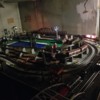The logic isn't flawed, if you are willing to live with the possible drawbacks. ...Cant think 0-27 ?  .
.
Track powered accessories and bulbs are cheaper than a cooked board from some errant over voltage unnoticed. Lights being too bright, out, flickering, blackened, etc. a visual warning for sure.
You guys have been away from carpet centrals and conventional for too long; spoiled 
Some lighting brightness varience can be minimally important, e.g. ceiling layout, 5 blocks on a Z & #1 on a KW, lots of hands free operation leaves everything pretty steady too, I use two lighted bridge houses, a yard light, and single street lamp (out of a row on constant power) is wired to the track. It's light change being less noticable caught in the brighter light of an operating luggage station whose light is on constant power too, while the ground switched station motor is on track power. That's what neutral, and on/off switches are for; go to nuetral, turn on the accessory and adjust power 
Another layout has an open air depot who's light being on (a constant on) means it's siding will get (varible) track power. ..."Open for buisness"  It also has a tiny, dim, bumper bulb on the mains variable power. The next line has a lighted bumper as well. Another line, an el, has a single overhead lamp under an el trestle over another line. Again, near brighter lights so it is not as noticeable; and below where you look as youd adjust, and under a rail line if the train is overhead it looks like the train vibrations are causing a dim light to flicker on fully
It also has a tiny, dim, bumper bulb on the mains variable power. The next line has a lighted bumper as well. Another line, an el, has a single overhead lamp under an el trestle over another line. Again, near brighter lights so it is not as noticeable; and below where you look as youd adjust, and under a rail line if the train is overhead it looks like the train vibrations are causing a dim light to flicker on fully 

A tiny 24v grain of wheat porch light used is for the final line. It's filiment glows (not "lit") at 5v and the 1033 maxs at 15v
My Christmas table uses L.e.d.s, diodes, and 6 toggles for 1.5v steps of d.c. to 12v as the trottle(s). BUT it is hidden. There is also a ring of red 1.5v Chistmas bulbs, 2 groups of 5 in series, circling the track, powered by the track that lets you know if power is applied.








